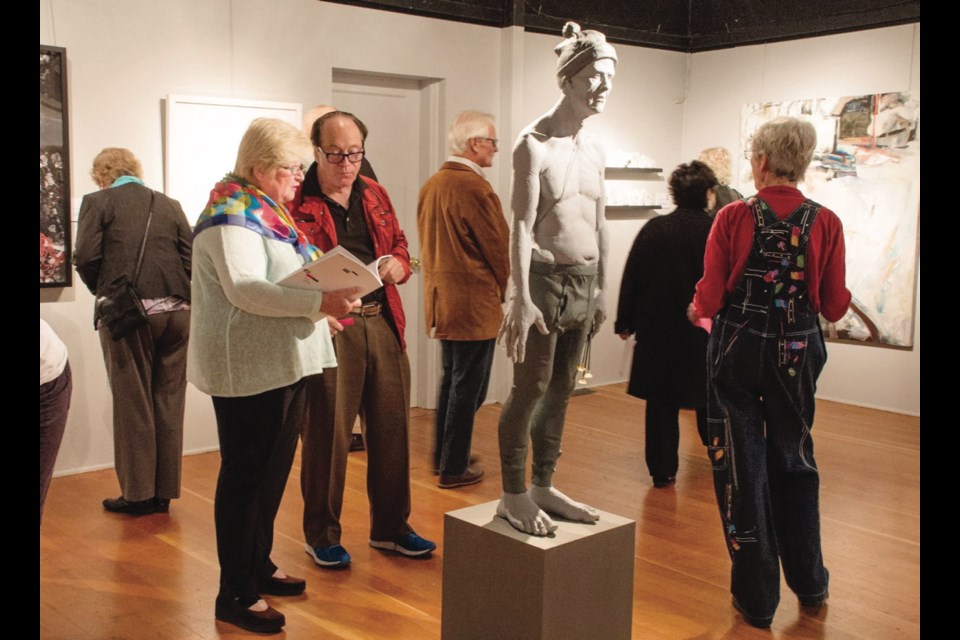There’s a new prize for art, the Salt Spring National Art Prize. The show, on now at the Mahon Hall at Ganges on Salt Spring, presents a fine selection of work by 52 artists from six provinces and the Yukon Territory, and it’s causing quite a buzz.
As the art writer for the Times Colonist, I was invited to take part in a panel discussion on the arts in Canada, one of many activities to celebrate the opening of the exhibition. The jurors’ prizes and People’s Choice award will be presented at a gala on Oct. 24 at Mahon Hall in Ganges, and the works are all online at saltspringartprize.ca.
I confess I was a bit underwhelmed when I first heard about this juried art show on a Gulf Island. But I read further. The $25,000 in cash awards brought forth 1,376 pieces by more than 800 artists. The judges, from Newfoundland, Winnipeg and Salt Spring Island, chose sculpture, painting, prints, photography and mixed-media artworks that “demonstrate a visual impact and depth of meaning.”
The Salt Spring Arts Council planned the event with care, engagement and professionalism. Because the visiting panelists were expected to be present both Friday and Saturday nights, I planned a weekend on the island with my wife, Sarah, knowing there would be much to experience.
Across Canada, everyone knows that this, of all the blessed Gulf Islands, is the Canadian Shangri-la. The hills are alive with hand-built homes made of wood and stone, designed by legendary architects and inhabited by a rich cocktail of the wealthy, back-to-the-landers and artists. There are inspiring views of the Salish Sea in every direction.
Our “bed and breakfast” was more than that name implies. The winding drive to the Stonehouse (saltspringstonehouse.com) is lined with upright boulders, leading to the full-scale circle of standing stones, some five metres tall, presiding over a ridge above Ganges Harbour. The effect is, as they say, awesome. Ron Crawford, a Salt Spring resident for 25 years, is the driving force behind the art prize and, as I learned, he had erected those standing stones.
On Friday night, downtown Ganges was thronged, and more than 400 people paid admission to the “historic” Mahon Hall, a classic village hall transformed into a spacious and pleasant exhibition site. The contents of the show were a complete surprise, and every piece was engaging.
While the artists were almost all unknown to me, the art was intriguing on many levels, and each piece had a carefully crafted artist’s statement beside it. Collectors were buying, people were talking, local artists were meeting the visitors. A full printed catalogue was available at this opening. From the word “go,” this was a success.
In former times, artists met their public through such competitions, such as the Royal Academy’s Summer Exhibition in London. In Canada during the 1950s and 1960s, almost every city had an annual juried show. Such shows have faded because of the difficulties of insurance, the fracturing of the definition of art and the reluctance of the best artists to submit to jurying.
Victoria’s Look show, organized by the Community Arts Council, is a vestige of those days. Yet, as the Sooke Fine Art Show demonstrates, the idea still has life. These days, it works best in small communities, where people are accustomed to working together, rather than in the self-absorbed bigger cities.
The art-prize committee raised more than $100,000 to create a foundation. My panel discussion was the project of organizer Susan Benson and moderator Janet Halliwell, each of whom brought long experience to bear on improving the cultural life on the island, and in Canada. Joan McConnell, a spry 90-year-old, donated the $25,000 prize money, and many others made generous contributions of time, money and resources.
Our panel discussion took place in Artspring, the excellent community theatre with attendant gallery spaces. Our conversation began Saturday night over dinner. The other panelists were Jim Erickson (Salt Spring resident, Oscar winner for set design), Michael Shamata (artistic director of Victoria’s Belfry Theatre), Kathy Page (Salt Spring’s multi-award-winning novelist) and Veronica Tennant (of Toronto, former prima ballerina of the National Ballet and documentary film producer).
Table talk rose to a peak, and after dinner we were whisked away to Artspring, there to be met by five precociously intelligent students from the Gulf Island High School performing arts program. These kids were eloquent about their ideas for the arts in Canada, but it was time to take our places on stage.
Moderator Halliwell guided us through two hours of our anecdotes, spirited diatribes against the present government, calls of support for the CBC and the funding of education, and recognition of the vibrant resurgence of native culture. Afterward, we had an informal hour with the well-informed audience.
Subsequent discussions by invited curators and talks by 10 of the chosen artists are taking place throughout the month.
I’m glad I saved some time to visit some of the island’s galleries. I recommend Rosalie Matchett’s encaustics of beehive culture at the Duthie Gallery (until Oct. 15, gallerybb.blogspot.ca), with its extensive outdoor sculpture park. At the Pegasus Gallery (pegasusgallery.ca), First Nations baskets of museum quality caught my eye.
I came away certain that cultural tourism, and well-educated and creative youth, are our best hope for the future. Let the SSNAP show lure you to Salt Spring Island.
Salt Spring National Art Prize (at Mahon Hall, 114 Rainbow Rd., until Oct. 25; online at saltspringartprize.ca).
